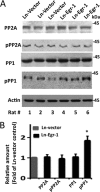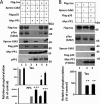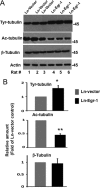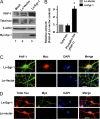Early growth response 1 (Egr-1) regulates phosphorylation of microtubule-associated protein tau in mammalian brain
- PMID: 21489990
- PMCID: PMC3121503
- DOI: 10.1074/jbc.M111.220962
Early growth response 1 (Egr-1) regulates phosphorylation of microtubule-associated protein tau in mammalian brain
Abstract
In the normal brain, tau protein is phosphorylated at a number of proline- and non-proline directed sites, which reduce tau microtubule binding and thus regulate microtubule dynamics. In Alzheimer disease (AD), tau is abnormally hyperphosphorylated, leading to neurofibrillary tangle formation and microtubule disruption, suggesting a loss of regulatory mechanisms controlling tau phosphorylation. Early growth response 1 (Egr-1) is a transcription factor that is significantly up-regulated in AD brain. The pathological significance of this up-regulation is not known. In this study, we found that lentivirus-mediated overexpression of Egr-1 in rat brain hippocampus and primary neurons in culture activates proline-directed kinase Cdk5, inactivates PP1, promotes tau phosphorylation at both proline-directed Ser(396/404) and non-proline-directed Ser(262) sites, and destabilizes microtubules. Furthermore, in Egr-1(-/-) mouse brain, Cdk5 activity was decreased, PP1 activity was increased, and tau phosphorylation was reduced at both proline-directed and non-proline-directed sites. By using nerve growth factor-exposed PC12 cells, we determined that Egr-1 activates Cdk5 to promote phosphorylation of tau and inactivates PP1 via phosphorylation. When Cdk5 was inhibited, tau phosphorylation at both proline- and non-proline directed sites and PP1 phosphorylation were blocked, indicating that Egr-1 acts through Cdk5. By using an in vitro kinase assay and HEK-293 cells transfected with tau, PP1, and Cdk5, we found that Cdk5 phosphorylates Ser(396/404) directly. In addition, by phosphorylating and inactivating PP1, Cdk5 promotes tau phosphorylation at Ser(262) indirectly. Our results indicate that Egr-1 is an in vivo regulator of tau phosphorylation and suggest that in AD brain increased levels of Egr-1 aberrantly activate an Egr-1/Cdk5/PP1 pathway, leading to accumulation of hyperphosphorylated tau, thus destabilizing the microtubule cytoskeleton.
Figures










Similar articles
-
Inhibition of Early Growth Response 1 in the Hippocampus Alleviates Neuropathology and Improves Cognition in an Alzheimer Model with Plaques and Tangles.Am J Pathol. 2017 Aug;187(8):1828-1847. doi: 10.1016/j.ajpath.2017.04.018. Epub 2017 Jun 20. Am J Pathol. 2017. PMID: 28641077
-
Phosphorylation of protein phosphatase 1 by cyclin-dependent protein kinase 5 during nerve growth factor-induced PC12 cell differentiation.J Biol Chem. 2007 Mar 2;282(9):6619-28. doi: 10.1074/jbc.M606347200. Epub 2007 Jan 3. J Biol Chem. 2007. PMID: 17202132
-
Isomerase Pin1 stimulates dephosphorylation of tau protein at cyclin-dependent kinase (Cdk5)-dependent Alzheimer phosphorylation sites.J Biol Chem. 2013 Mar 15;288(11):7968-7977. doi: 10.1074/jbc.M112.433326. Epub 2013 Jan 28. J Biol Chem. 2013. PMID: 23362255 Free PMC article.
-
The protein kinase Cdk5. Structural aspects, roles in neurogenesis and involvement in Alzheimer's pathology.Eur J Biochem. 2001 Mar;268(6):1518-27. doi: 10.1046/j.1432-1033.2001.02024.x. Eur J Biochem. 2001. PMID: 11248668 Review.
-
Physiological and pathological phosphorylation of tau by Cdk5.Front Mol Neurosci. 2014 Jul 15;7:65. doi: 10.3389/fnmol.2014.00065. eCollection 2014. Front Mol Neurosci. 2014. PMID: 25076872 Free PMC article. Review.
Cited by
-
Low dose nicotine attenuates Aβ neurotoxicity through activation early growth response gene 1 pathway.PLoS One. 2015 Mar 27;10(3):e0120267. doi: 10.1371/journal.pone.0120267. eCollection 2015. PLoS One. 2015. PMID: 25815723 Free PMC article.
-
SNCA genetic lowering reveals differential cognitive function of alpha-synuclein dependent on sex.Acta Neuropathol Commun. 2022 Dec 14;10(1):180. doi: 10.1186/s40478-022-01480-y. Acta Neuropathol Commun. 2022. PMID: 36517890 Free PMC article.
-
Epigenetic induction of EGR-1 expression by the amyloid precursor protein during exposure to novelty.PLoS One. 2013 Sep 16;8(9):e74305. doi: 10.1371/journal.pone.0074305. eCollection 2013. PLoS One. 2013. PMID: 24066134 Free PMC article.
-
Pathways to neurodegeneration: mechanistic insights from GWAS in Alzheimer's disease, Parkinson's disease, and related disorders.Am J Neurodegener Dis. 2013 Sep 18;2(3):145-75. Am J Neurodegener Dis. 2013. PMID: 24093081 Free PMC article. Review.
-
Early and sustained altered expression of aging-related genes in young 3xTg-AD mice.Cell Death Dis. 2014 Feb 13;5(2):e1054. doi: 10.1038/cddis.2014.11. Cell Death Dis. 2014. PMID: 24525730 Free PMC article.
References
Publication types
MeSH terms
Substances
Grants and funding
LinkOut - more resources
Full Text Sources
Molecular Biology Databases
Miscellaneous

